The following article by Valerie Rhea originally appeared on Quora. Valerie is a thirty-something PhD economist, former military pilot, with a law degree.
Trump’s Tariffs vs. Smoot-Hawley

Smoot-Hawley was a tariff passed by Congress in 1930 as a misguided attempt to protect US jobs during the Great Depression that had begun the prior year with the 1929 meltdown of the US stock market. Impacted industries feared the fallout of the Great Depression and lobbied Congress extensively in hopes that Congress would enact tariffs that protected US industry from foreign competition. In the end, their intense lobbying carried the day, but the result was not what they expected.
Smoot-Hawley proved disastrous. In the 1930s, the depression had already created an environment where worldwide trade was fragile, and the US was in a very different trade position compared to today. Smoot-Hawley was a broad, reactive measure implemented during a depression when trade was already weak and few worldwide agreements were in place to check retaliations or resolve trade disputes. On top of this, the depression impacted US consumer spending drastically, so US markets weren’t seen as being as vital to foreign interests, making retaliation more likely. The net result was an overall erosion in global trade that would take several years to resolve.
Today, Trump’s tariffs are strategic, targeted, and implemented during an otherwise robust economy (at least, compared to the rest of the world). They aren’t broad and simple measures but rather are intended to address specific geopolitical and economic grievances. Furthermore, today’s world trade is more integrated and regulated, with agreements like USMCA, GATT, WTO, and so on existing to provide a framework for discussions and remedies. As we saw just in the past day or two, Trump also has the ability to pivot quickly, so any unforeseen damage from his tariff plan can be averted by simply changing tactics in real time.
Trump is also creatively using a system of rewards to make his case, his so-called “carrot and stick” approach. It’s not just about using tariffs to protect US industries – it’s about convincing producers on the global stage to relocate production capacity to the US, with the reward being that those who manufacture in the US pay no tariffs while getting favorable tax treatment. It’s too early to tell how effective this will be. Still, given the massive size of the US market, it is entirely sensible for producers to have production capacity as close as possible to the US consumer. Producers from BMW, Toyota, Novo Nordisk and many others figured this out a long time ago – Trump’s current economic policies just accelerate the appeal.
More importantly, today’s trade balance is very different, with the US running significant trade deficits with many other nations. The US is somewhat unusual – only 23% of our GDP depends on exports, while many nations are in the 60–70% range…America enjoys the luxury that the world’s biggest and most profitable market is our domestic market. These facts generally mean that our trading partners need access to the US market much more than American firms need access to foreign markets.
Also, in today’s world economy, many nations are experiencing relatively low GDP growth while struggling to maintain massive government spending. Canada, for instance, has been seeing about 1% annual GDP growth, and with about 20% of Canada’s GDP dependent on trade with the US, it’s clear that any slowdown in US purchases of Canadian products can easily drive the Canadian economy into recession. Many nations are in similar positions, making it extremely risky for them to engage in the type of retaliatory tariffs seen back in the 1930s after Smoot-Hawley.
The bottom line is that Trump’s tariffs are an intriguing idea. Trump’s challenge is to encourage Americans to consume more domestically made products while luring foreign investment and manufacturing here. For every billion in net new domestic production Trump gets, about 5000 US jobs are created, and large-scale investments of the type he’s been touting, if they continue, can add trillions to US GDP.
This is the big difference between Smoot-Hawley and what we see today. While Smoot-Hawley was intended to be trade protectionism to guard an already fragile US economy, Trump’s strategy is all about growth and using tariffs as a strategic weapon to lure capacity to the US and lower trade barriers elsewhere to open up foreign markets to US products.
Right now, the US economy is about $28 trillion. About 38% of that is government spending, with about $2 trillion being Federal deficit spending using debt. Compared to a nation like France (which spends almost 57% of its GDP on government), this may sound strong, but it is a massive obstacle to economic growth and prosperity.
If Trump’s plan succeeds, the American economy could see about $4 trillion added through economic growth and about $2 trillion in cuts due to Trump’s DOGE efforts. That leaves us with $30–32 trillion in GDP while reducing the government’s share of GDP from 38% today to 26% and eliminating the Federal deficit. If this materializes, it would be a victory of epic proportions for the US.

Economist Valerie Rhea’s commentary seems always on-point, informative, and illuminating.
Thanks, Valerie.
NE